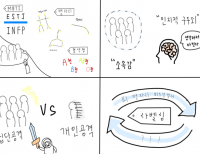One anonymous student at Kyonggi University is worried because he is into "short form" these days. Originally he only watched them for a little while before going to bed, but soon the viewing time was up to 2 to 3 hours. He couldn't sleep, his concentration decreased and he had problems with his studies. This may be a common concern among the younger generation, not just for a few anonymous classmates. Short-form content, which refers to videos of 60 seconds or shorter, is a worldwide trend. So what is a short-form? Short-form refers to content presented in short videos that usually do not exceed an average of 15 to 60 seconds, although sometimes they may be up to 10 minutes. They are gaining huge popularity from the MZ generation who want to enjoy not only information acquisition but also fun in a short period of time. Various social media platforms are developing functions to produce and share short-form content.

As the number of people who consume short form content for entertainment increases, the content of short-form is also diversifying. Clips of drama or movies, stimulating experiments that will attract people's attention, and even today’s headline news video clips are made and shared in short-form videos. The popularity of short-form has been increasing day by day. According to an announcement by a research institute, short-form viewing times on platforms such as YouTube, TikTok, and Instagram average 46 hours and 29 minutes per person per month. You can easily see fast-paced short-form videos on people's smartphone screens even on the subway. YouTube has stated that the average number of views per day on ‘Shorts’ exceeded 50 billion in 2022, and Instagram’s short-form platform ‘Reels’ and Tik Tok’s users have increased day by day. Gags, sports, games, pets, and even TV programs – every type of video content is being presented short and fast. Challenges, which parody popular dances or videos, is a participatory type of short-form content that anyone can take and upload, and this is a window into the latest trends. The influence of short-form is enormous, with a Korean high school student who recently shot the globally popular ‘Slickback Challenge’ achieving more than 200 million views on TikTok and appearing on the TVN entertainment show U Quiz on the Block. Now short-form has become popular among every age group. The younger the age group, the higher the rate of short-form content use, but the elderly over age 60 also have a lot of experience watching short-form content, which means all age groups are consuming short-form content.
However, neurologists say that these short-form videos are not good for our brains because they provide too much dopamine to people. Experts said that children whose brains have not fully grown are exposed to short form for a long time, which greatly affects concentration and literacy. The simplicity of short-form videos which usually use short and provocative words makes the process of interpreting and understanding long-forms, that is, long sentences or videos, dull. Pursuing strong stimulation for a short time releases dopamine in our brain, and if the secretion of dopamine exceeds a certain level, only greater stimulation is pursued, and if this process is repeated, ‘‘short-form poisoning” occurs.
Why is “short-form poisoning” dangerous? The reason why short-form addiction occurs is that people highly value time in addition to the addictive nature of the short-form content itself. There is no reason to watch 3-minute videos to get information that we can get in 30 seconds. At the same time, short-form videos’ popularity has increased. As the amount of information that can be obtained from short-form content grows, short-form content is naturally consumed more. The reason why this short-form addiction is dangerous can be explained in connection with the smartphone overdependence phenomenon. Smartphone overdependence refers to a state in which smartphones are prioritized in daily life due to excessive use of smartphones. The ability to control usage decreases, and accordingly, physical, psychological, and social problems occur. When we fall into such a state of dependence on our smartphones, we only look at our smartphones regardless of time and space. If our conversation time with others is significantly reduced, and our smartphone is not visible, we will even experience anxiety symptoms. Furthermore, there are cases where big accidents occur because we are always immersed in using our smartphones instead of being aware of our surroundings.
When we see stimulating images, our brains produce dopamine, a pleasure hormone. If these stimuli continue, resistance develops. Eventually, we find a bigger and immediate stimulus and become desensitized to the slow and weak stimulus of reality. We may already be dopamine poisoned. What should we do to solve these problems? First, a solution must be found at the national level. In some states in the United States, a bill has been passed that allows minors under the age of 18 to sign up for TikTok, Instagram, and Facebook only with the consent of their parents. However, in Korea, there is no institutional regulation at the government level yet. In Korea, the government should step up as soon as possible and actively work on solving the problem. On a personal level, if it is difficult to control the viewing time by yourself, it is a good idea to delete the short-form app. Also, even if you watch short-form videos, it is good to take a break. At this time, it is good to change the type of content you enter into your brain through the act of viewing photos, pictures, or reading text. People who are satisfied with the real offline world are not addicted to short-form content and their daily lives are not ruined. Having fun in your daily life and being addicted to being healthy is the best way to get away from short-form addiction.
80th Reporter • CHOI JUN HONG • chloi0058@naver.com
81st Reporter • CHO SE RYOUNG • sceyesgaze@kyonggi.ac.kr
- TAG
-
 Freedom Given to Youth: An Opportunity for Choice or a Burden of Constraint?
“Are we truly free today?” Classical literature is far more than time-honored stories. It offers profound insights into human nature and society that transcend time, remaining a valuable resource for examining the challenges our world faces today. This article will draw on George Orwell’s 1984 and Charles Dickens’ Oliver Twist to explore the contemporary issues of youth housing and the emergence of a surveillance society ...
Freedom Given to Youth: An Opportunity for Choice or a Burden of Constraint?
“Are we truly free today?” Classical literature is far more than time-honored stories. It offers profound insights into human nature and society that transcend time, remaining a valuable resource for examining the challenges our world faces today. This article will draw on George Orwell’s 1984 and Charles Dickens’ Oliver Twist to explore the contemporary issues of youth housing and the emergence of a surveillance society ...

 [단신] 산악회, 본교 동문의 버팀목이 될 수 있도록
[단신] 산악회, 본교 동문의 버팀목이 될 수 있도록
 [사회메인] 노인 인구 1,000만 시대, 준비 없는 사회가 불안해
[사회메인] 노인 인구 1,000만 시대, 준비 없는 사회가 불안해
 [네컷만화] 라벨링 문화
[네컷만화] 라벨링 문화
 [진리터] 결국 우리 모두 돌아볼 것이니
[진리터] 결국 우리 모두 돌아볼 것이니

 목록
목록











